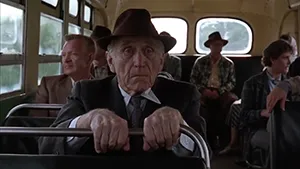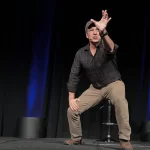
How Framing Shapes Emotion and Storytelling
In filmmaking, every camera angle, every movement, and every frame composition is an intentional psychological choice. The way a scene is shot doesn’t just capture action—it tells a deeper story, guiding the audience’s emotions and reinforcing a film’s themes in ways they may not even consciously recognize.
One of the most powerful examples of the psychology of camera angles comes from The Shawshank Redemption (1994), particularly in the scenes where two long-time prisoners, Brooks Hatlen and Ellis “Red” Redding, are released from Shawshank Prison. Though both men experience the same event—walking free after decades of confinement—the way their scenes are framed and shot tells two completely different psychological stories.
Framing Freedom: Brooks vs. Red
When Brooks Hatlen is paroled after spending most of his life behind bars, the moment should feel triumphant—except it doesn’t. Instead of emphasizing his newfound freedom, the camera frames him in a way that still makes him look imprisoned.
 •As Brooks steps out of the prison gate, the bars remain in the background, a visual cue that he isn’t truly free. Though he has physically left Shawshank, his mind is still trapped inside it.
•As Brooks steps out of the prison gate, the bars remain in the background, a visual cue that he isn’t truly free. Though he has physically left Shawshank, his mind is still trapped inside it.
•The camera remains mostly static, almost observational, mirroring Brooks’ own emotional stillness. He has no sense of where to go or how to function, and the lack of camera movement reinforces that stagnation.
•The cinematography boxes him in even outside the prison, framing him in small, confined spaces, such as his tiny room at the halfway house or the bustling streets that feel chaotic and overwhelming. The world itself feels like another kind of cage to him.
Contrast this with Red’s release scene. When Red is finally paroled, the moment is visually and emotionally completely different.
 •Instead of the prison staying in frame behind him, the camera follows Red as he walks out, moving with him as he steps into the world.
•Instead of the prison staying in frame behind him, the camera follows Red as he walks out, moving with him as he steps into the world.
•This small but crucial choice conveys motion and transition—unlike Brooks, Red has a chance at a future beyond Shawshank.
•The tracking shot places the audience in his perspective, making us feel his journey more personally. Unlike Brooks, who is filmed as if being observed from a distance (isolated and powerless), Red’s scene feels immersive, inviting us into his experience.
These two scenes—nearly identical in concept but radically different in execution—show how camera framing and movement can completely transform the meaning of a moment.
The Psychology Behind Camera Angles
Filmmakers use camera angles and framing as a kind of silent storytelling, creating subconscious associations in the minds of the audience. The way a character is framed in a scene can subtly influence how we interpret their state of mind.
•Static vs. Dynamic Framing – Brooks is framed statically, often kept in center frame with little movement. This reflects his emotional stagnation—he is unable to move forward. Red, however, is filmed with tracking shots, symbolizing growth, transition, and a journey toward something new.
•Perspective and Immersion – Brooks’ scene keeps the audience at a distance, making us feel like detached observers, just as he feels disconnected from the world. Red’s scene, in contrast, places the audience in motion with him, allowing us to feel his hope and uncertainty in real time.
•Symbolism Through Composition – The bars behind Brooks serve as a metaphor for his psychological imprisonment, reinforcing that he never truly left Shawshank. Red’s lack of bars in his framing signifies his ability to mentally break free, even before he reaches that iconic beach reunion with Andy.
The Larger Implications: How Framing Affects Storytelling
These small cinematographic choices shape how we emotionally engage with a film. Even if the audience doesn’t consciously register them, the framing and movement evoke specific feelings that deepen our connection to the characters.
In The Shawshank Redemption, the camera doesn’t just show two men leaving prison—it shows two different fates. Brooks, unable to cope with life beyond Shawshank, ultimately ends his own life, reinforcing that freedom is more than just physical—it’s mental. Red, though struggling at first, ultimately embraces life outside of Shawshank, fulfilling Andy’s promise that “hope is a good thing.”
Had the film framed Red’s release the same way as Brooks’, the audience might have felt an impending doom rather than hope. Had Brooks’ release been shot with more movement and open framing, we might have believed he had a chance at adjusting to freedom. The way a scene is framed literally changes how we perceive the story.
The Takeaway: Why Camera Angles Matter in Filmmaking
Every director and cinematographer understands the psychology of camera angles and framing is more than just aesthetics—it is a way to control emotion, guide interpretation, and reinforce themes. In The Shawshank Redemption, camera movement and framing visually distinguish between a man who never truly left prison and one who was able to escape not just the walls, but the mental prison built around him.
This is why framing is one of the most powerful psychological tools in filmmaking. The way a character is shown on screen—where they are positioned, how the camera moves, what elements surround them—completely transforms how we feel about them.
So next time you watch a movie, pay attention to how the camera is framing the characters. Is the scene confining them, or giving them space? Is the camera moving forward with them, or leaving them behind? The answer may reveal more about their fate than any line of dialogue ever could.
Citations:
1.Bordwell, David, & Thompson, Kristin. (2019). Film Art: An Introduction. McGraw-Hill Education. – A foundational text on film analysis, including camera movement and framing psychology.
2.Giannetti, Louis. (2020). Understanding Movies. Pearson. – Discusses cinematography techniques, including camera angles and psychological framing.
3.Ebert, Roger. (1999). Review of The Shawshank Redemption. RogerEbert.com. – Highlights the film’s visual storytelling and emotional impact.
4.Bateman, Chris. (2013). Imaginary Games. Bloomsbury. – Explores how audience perception is shaped by visual storytelling techniques.
5.Brown, Blain. (2016). Cinematography: Theory and Practice. Focal Press. – Explains how camera angles influence narrative and audience emotion.
6.Moura, Gabriela. (2021). The Psychology of Cinematography: How Framing Affects Emotion. The Film Stage. – Discusses the psychological effects of different framing techniques in film.
7.Deakins, Roger. (1994). The Shawshank Redemption: Cinematography Breakdown. American Cinematographer Magazine. – A deep dive into Deakins’ cinematographic choices in The Shawshank Redemption.
These sources provide insights into the psychological effects of camera framing, cinematographic techniques, and how film language influences storytelling—particularly in the context of The Shawshank Redemption.









